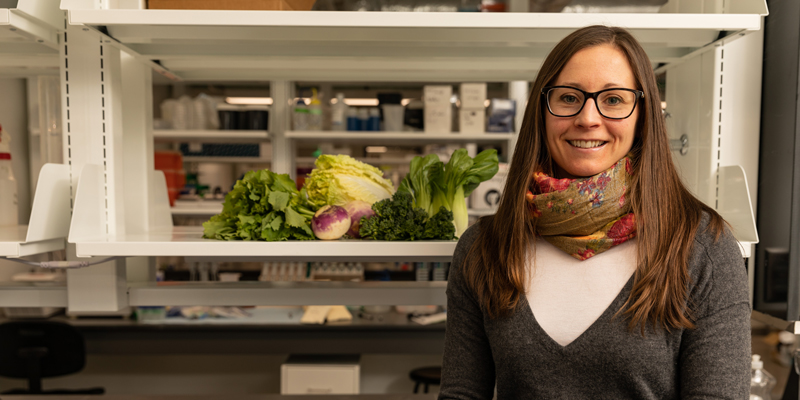Pinpointing when processes are happening in plants could set the stage for improving food crops and producing better biofuels.

We all run like clockwork as it turns out (even those of us who struggle to be on time). People, plants, even microbes have an internal “clock” that determines when certain things happen. We associate the clock, or circadian rhythm, most closely with sleep patterns, but that’s just one of many processes influenced by the ubiquitous timekeeper. In plants, the clock plays a key role in when processes critical to survival and reproduction happen. Without it, they might not be able to successfully navigate the complex realities in which they live rife as it is with existential threats from predatory insects and inhospitable conditions.
Katie Greenham, who is an assistant professor in the Department of Plant and Microbial Biology, didn’t set out to study circadian rhythms in plants. She happened upon it, but quickly understood the significance of what she had stumbled on. Greenham realized that when a process happened might be as important (if not more) than what was happening, and knew she had to continue investigating. “It’s a love-hate thing because you realize this clock is controlling everything that you worked on before and you hadn’t been considering it,” she says.
Given that climate change is threatening food production, scientists like Greenham have embraced the challenge of improving how plants defend themselves against rapidly changing environments. For those looking to identify traits that might be useful for improving food crops and producing better biofuels such as Greenham, deconstructing how the clock works is a step toward fine-tuning processes that benefit plants and, by extension, people.
“Standard breeding techniques take years and it’s difficult to maintain the traits,” says Greenham. “Now we know where the gene is, but it’s the nucleotide sequence around the gene that creates the expression patterns. Those are the regulatory regions we want to bring into other plants.”
Greenahm studies Brassica rapa, a diverse species that encompasses plants as seemingly different from one another as Chinese cabbage and turnips. That range is a big asset in the lab since it means that she can observe and test ideas easily given the wide range of attributes present within the species. But it’s arduous work involving RNA sequencing. Greenham says tissue must be sampled every few hours over days to get a clearer picture of gene expression," which Greenham describes as “a pattern like a wave” that changes throughout a day, and reproduce those patterns in related plants.
“I’m really interested in what’s creating these rhythms and what’s determining when the plant responds,” says Greenham. “I look at which genes are changing over the course of the day — so just like these rhythmic responses the genes themselves are being turned on and off at different times of day.” Easier said than done, of course, since these patterns aren’t produced by a single gene but rather a series of many genes and proteins that act in these negative feedback loops that move in multiple directions.
“Hopefully what we learn in Brassica we can apply to canola, soybean and maybe even corn,” says Greenham. “My feeling is let’s work with the clock rather than against it and try to adjust the timing of these responses to improve the stress tolerance while leaving the other traits the same.” – Stephanie Xenos